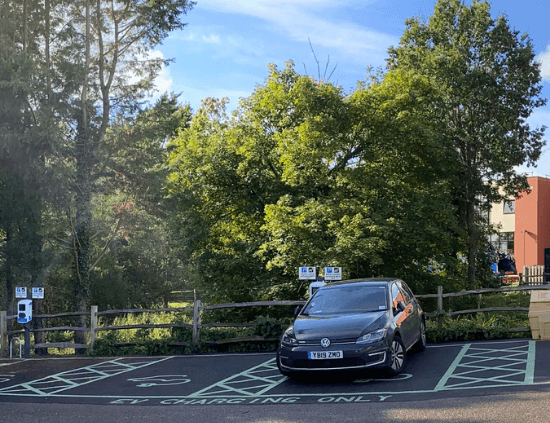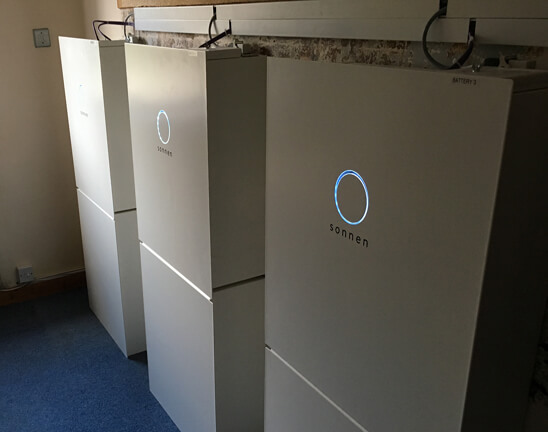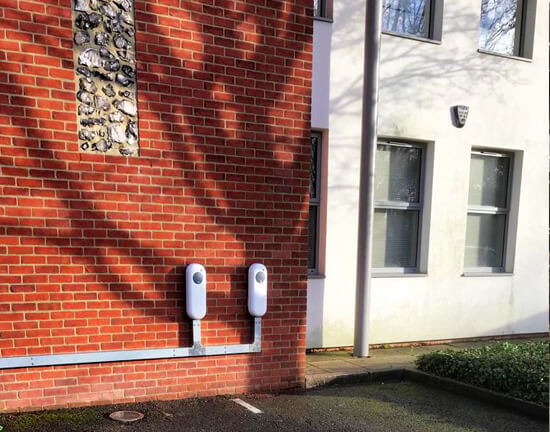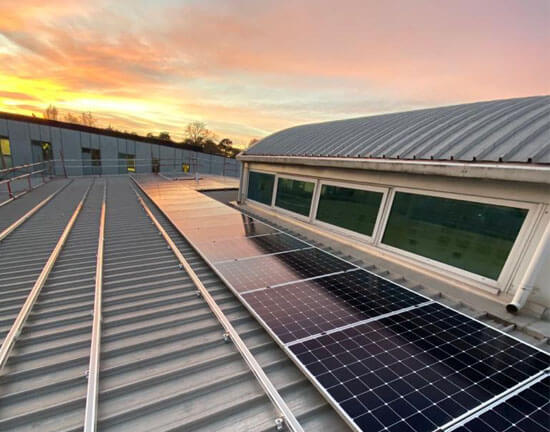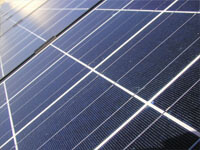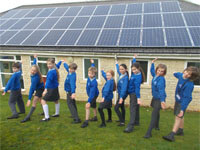Installing solar panels on schools is an effective way of reducing running costs, while simultaneously acting as a hands-on educational resource for engaging students with sustainability

Solar Panels for Schools
School Solar Panel Installations
Watts aren’t the only energy generated from solar panels: they can have a far more significant impact in opening eyes and inspiring minds.
And no solar energy system has more potential for this than one built on a school roof.
Solar panels for schools are a Joju Solar speciality. Over the last decade, we have installed more than 150 solar schools – more than anyone else in the country. With our help, many schools have turned their roofs into a source of new income, and a fresh new educational resource for students and parents. It’s some of the most rewarding work that we do.
We’ve been the installation partner of choice for major UK solar schools programmes – the Schools’ Energy Coop, 10:10 Solar Schools, Friends of the Earth ‘Run on Sun’, Wey Valley Solar Schools, the Low Carbon Hub and Egni Coop. Many of these schemes come financed by the local community, so the installation doesn’t cost the school a penny.
Lower running costs
Visible commitment to a low carbon future
Demonstrate renewable energy works
Hands-on educational resource
Community financed solution
Solar Panels for Education
A solar power for schools project demonstrates a clear commitment to a sustainable energy future, and the students can feel proud that their school is ‘walking the walk’. When some are still sceptical about the benefits of solar, a school solar array is visible proof that this technology works – cleanly and silently too. The schools we work with are often Eco-schools or have dynamic student green groups. A major solar panel project can be a real source of inspiration to them. And we only need look at the school strikes to know that there is real passion for all aspects of environmental change.
Teachers can integrate solar power education into many aspects of the curriculum
- Physics – how solar panels work, conversion of energy between different forms
- Geography – the variability of the solar energy resource worldwide
- Maths – solar output datasets can be used for teaching statistics in a tangible way
- Sustainability – energy and carbon literacy (knowing what a kWh or tone of carbon is) will be critical for future generations to understand
- Citizenship – understanding climate change, and how solar power can help, teaches how we can become responsible citizens in our care for the environment
We connect our school solar power systems to a smart generation meter. This meter logs all electricity produced to a centralised portal, every 15 minutes. The school will have access to this portal, and teachers can download the high-resolution numerical datasets for use in their lessons.
Many of the schools we work with have also opted to have a display board installed somewhere public in the school. This board gives real-time information on the electricity produced so that students can relate this to the weather outside. It also shows the total generation and the amount of carbon that has been saved by the schools solar panels. And of course, parents and teachers find this fascinating too!

Funding Solar School Installations
We do understand that most schools don’t have ample funds of cash for purchasing a school solar installation. That’s why we’ve teamed up with some of the largest community energy groups in the country to deliver our solar for schools programmes.
Community energy groups raise finance within their local community to pay for the solar installation, so the school does not have to spend a penny. The electricity produced is then sold to the school at a subsidised rate. So if the school were paying 12p/kWh for their electricity, the community group would sell power to the school for about 9p/kWh, giving the school immediate bill savings of 25%. Selling the electricity to the school in this way is enough to pay back the investors over time. It also generates a small surplus over time that can fund further environmental projects within the local area. And we’re sure your students will have loads of great ideas for these kinds of projects!
We can arrange funding from our main solar schools partner – the Schools Energy Coop. Sometimes, however, we find a project is better suited to one of our more local partners, such as Egni Coop in Wales or the Low Carbon Hub in Oxfordshire. We can work at any scale, from individual schools to Academy chains, or even the entire portfolio of a local council.
Batteries and Charge Points for Schools
It’s not just solar panels – we do also offer other green technologies for schools.
It is possible to install battery storage in schools, which can act as a further exemplar of green technology to the students. Turners Hill Primary School, for example, installed batteries and has reduced their electricity demand to zero for much of the year. However, because schools are mainly in use during the day, they can benefit directly for solar without the need for a battery. In most cases, it is hard to create a financial case for batteries in schools, so this is very much a ‘nice-to-have’ should funds be available.
We will see increased demand for EV charge points for schools over the coming decade. Teachers and parents will want to drive their electric cars to school and be able to charge up, as they would do at any workplace.
More interestingly, a bank of EV charge points in schools could become a community car charging hub. A charging hub would serve anyone in the local area, and in particular, residents who do not have driveways (and therefore charge points) of their own. Schools can use their position as a focal point of the community to provide clean electric mobility to their neighbours when it otherwise might not be possible.
What is Solar For Schools?
Solar for schools is the installation of solar panels to generate electricity for schools. It provides a sustainable energy source and can reduce energy costs. It also allows schools to educate students on renewable energy and reduce their carbon footprint.
What are the Benefits of Solar Panels For Schools?
Solar panels offer several benefits for schools, including:
- Cost savings: They can significantly reduce energy costs for the school, allowing more resources to be allocated towards other needs.
- Environmental sustainability: Solar energy is a clean, renewable energy source that produces no greenhouse gases, making it an environmentally friendly choice.
- Educational opportunities: Solar panels can provide opportunities for students to learn about renewable energy and sustainable living.
- Energy independence and resilience: Solar panels can provide energy independence and resilience during power outages or other emergencies.
- Potential revenue: Schools may be able to earn revenue by selling excess energy back to the grid through feed-in tariffs.
That’s why solar panels are good for schools.
Solar Panels For Schools Cost
The cost of solar panels for schools can vary depending on a number of factors, including the size of the system needed, the location of the school, and the type of solar panels used. On average, the cost of a solar panel system for a school in the UK can range from £10,000 to £50,000 or more.
However, it’s important to note that the installation of solar panels for schools can often be subsidised by government grants and incentives, such as the Salix Finance scheme, which provides interest-free loans to public sector organisations for energy efficiency projects. The Schools’ Energy Coop, 10:10 Solar Schools, Friends of the Earth ‘Run on Sun’, Wey Valley Solar Schools, the Low Carbon Hub and Egni Coop are schemes that come financed by the local community, so the installation doesn’t cost the school a penny.
Additionally, schools may be able to benefit from reduced energy bills and potential revenue from excess energy produced by the solar panels through feed-in tariffs.
To get a more accurate estimate of the cost of solar panels for your school, it’s best to consult with a reputable solar panel installer such as Joju Solar and discuss your specific needs and circumstances.
Can Schools Get a Grant for Solar Panels?
Schools in the UK can apply for government grants and incentives to help fund the installation of solar panels. This scheme provides interest-free loans to public sector organisations for energy efficiency projects, including solar panel installations. By installing solar panels, schools can benefit from reduced energy bills and potential revenue from excess energy produced.
How Do I Get Solar Panels For My School?
To get solar panels for your school, find a reputable installer, get a quote, apply for funding, obtain necessary permits, and install the panels. Check for grants and government schemes to help with costs. Consider the school’s energy needs and potential savings.
Find out more about Solar for Schools
Solar PV
Solar PV is a clean and silent means of generating electricity directly from sunlight. We explain how to specify your system here.
Community Energy
You can raise the finance for your school solar roof from local community energy groups. Learn more about this cooperative movement.
EV Charging at Work
Like any workplace, schools will need electric vehicle charge points to serve teachers and parents. Explore your requirements with us.






